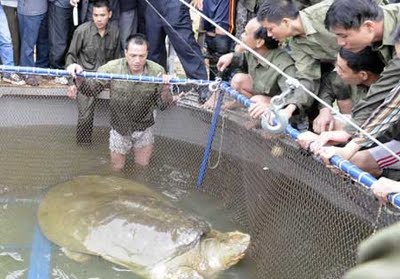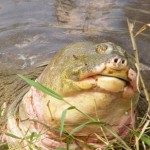Hoan Kiem Turtle Discovery
Posted by: Loren Coleman on April 21st, 2011

The Hoan Kiem turtle has been confirmed as a new species, after DNA analysis was performed.

Dr. Tran Binh, Director of the Institute for Biological Technology, on April 18, 2011, told Viet News that the institute had finalized the DNA test of the legendary turtle in Hanoi’s Hoan Kiem Lake. It is a new species.

Thanks to Chad Arment and Branden Holmes for passing along the news.
The following, previously published article, gives some further details of the pre-discovery story:
Rumors had been murmured for years of a mythical beast living deep in the waters of a northern Vietnam lake.
Some in a village west of Hanoi claimed to be blessed by catching a mere glimpse of the creature’s concave shell as it crested above the surface of their lake.
Maybe this was the reincarnation of a giant golden turtle of national legend that bestowed upon the Vietnamese people a magic sword and victory over Chinese invaders in the 16th century.
Whether that sacred turtle has materialized in the 21st century will be a matter of cultural debate among the Vietnamese.
But the fact that the species – known by scientists as a Swinhoe’s soft-shell turtle (Rafetus swinhoei) – is still alive in the wild at all is equally exhilarating news to scientists.
It’s especially exciting to researchers for the Cleveland Metroparks Zoo’s Asian Turtle Program. They will announce their discovery today.
“This is an incredibly important discovery because the Swinhoe’s turtle is one of the most critically endangered species of turtle in the world,” said Doug Hendrie, the Vietnam-based coordinator of the zoo program.
Hendrie said only three others are alive, all in captivity – two in Chinese zoos and the other cared for in the Hoan Kiem (“Returned Sword”) Lake in downtown Hanoi, the lake in which the legendary turtle appeared to reclaim the sword from the emperor.
“Finding one still living in the wild represents hope for the species – that others will be found and that the species will prevail in nature,” Hendrie said in an e-mail.
The zoo began its effort to preserve and protect Asian turtles in 2003 amid reports of increased killings for food or to make traditional medicine from their bones. Development and pollution also led to loss of nesting habitats along rivers, zoo officials said.
Hendrie said researchers have been aware of an Asian turtle crisis since the 1990s, but the Cleveland zoo “was really the first to step up to the plate and actually try to do something substantial.”
The zoo has put more than $275,000 into Asian turtle conservation efforts since 2000 and has supported Hendrie since 2003, officials said.
His team and scientists from Education for Nature-Vietnam had searched lakes and wetlands along the Red River for three years before hearing about the creature living outside Hanoi.
“This is one of those mythical species that people always talked about but no one ever saw, so it’s hugely significant,” said Geoff Hall, zoo general curator.
Significant, but not a certainty for its survival. “Our hopes are set on finding other turtles that have somehow been overlooked by hunters or were preserved in lakes and wetlands,” Hendrie said.
He said the turtle remains in the lake and that researchers notified the Vietnamese government of its existence.
The people of Vietnam, however, probably already were talking about it, said the Rev. Augustine Pham Lan of St. Boniface Catholic Church in Cleveland, who grew up in Vietnam.
“This is a well-known legend, part of their national his- tory and how Hanoi came to be the capital,” he said. “Vietnamese are very superstitious people, so the story that this turtle has returned will live on.”
Source: Cleveland Metroparks Zoo researchers find rare Swinhoe’s turtle living in wild in Vietnam, by Michael Scott, Cleveland Plain Dealer, April 16, 2008.

About Loren Coleman
Loren Coleman is one of the world’s leading cryptozoologists, some say “the” leading living cryptozoologist. Certainly, he is acknowledged as the current living American researcher and writer who has most popularized cryptozoology in the late 20th and early 21st centuries.
Starting his fieldwork and investigations in 1960, after traveling and trekking extensively in pursuit of cryptozoological mysteries, Coleman began writing to share his experiences in 1969. An honorary member of Ivan T. Sanderson’s Society for the Investigation of the Unexplained in the 1970s, Coleman has been bestowed with similar honorary memberships of the North Idaho College Cryptozoology Club in 1983, and in subsequent years, that of the British Columbia Scientific Cryptozoology Club, CryptoSafari International, and other international organizations. He was also a Life Member and Benefactor of the International Society of Cryptozoology (now-defunct).
Loren Coleman’s daily blog, as a member of the Cryptomundo Team, served as an ongoing avenue of communication for the ever-growing body of cryptozoo news from 2005 through 2013. He returned as an infrequent contributor beginning Halloween week of 2015.
Coleman is the founder in 2003, and current director of the International Cryptozoology Museum in Portland, Maine.










Critcally endangered soft-shelled turtle, eh?
I think the clue is in the name. I mean, how many Blunt Toothed Sharks, Bashful Bird-of-Paradise and Conspicuous Chameleons are still around?
This is awesome. That is a large animal, in a populated center, to go ”unknown”/”mythical” all these years.
I don’t know why, but this story has just made my day.
I believe that the individual in the lake was also believed to be a male before the DNA results confirmed it as a female. This means that it is the only known individual of its species (to be named Rafetus vietnamensis according to the article), and must therefore be considered as being listed as functionally extinct as the individuals in captivity are all Rafetus swinehoei.
However, Wikipedia states that it already has a scientific name, Rafetus leloii (Gray, 1873), which must take precedence. More likely, a redescription will be written in light of the anaylsis of the only individuals DNA.
Shouldn’t scientists try setting up a breeding program of some sorts? The article did say that there were two in China. So why not try to continue the species?
They have tried for several years to get the two individuals in Chinese zoos to breed. But it is believed that visitors have been feeding them junk food, which isn’t very conducive to positive breeding results unfortunately.
Could be the creature in the latest Champ cell phone video.
@PhotoExpert
They are trying to breed the two in China but it’s unsuccessful so far. However, this article is trying to say that leloii and the Yangtze River Turtle are not the same. This could explain why there is no success – the two turtles could be different species. However, another possibility is that the living turtles in China ARE the same species brought from Vietnam and that Swinhoei is long extinct. The unsuccessful breeding attempts can be explained by poor conditions and diet etc.
Until this DNA test is published, we won’t know for sure. In 2010 a group of Vietnamese researchers stated Leloii was a distinct species. The DNA testing done in 2010 was questioned by some since the samples weren’t given to GenBank as they promised to do so.
It is extremely odd they note the Dong Mo turtle is not the same… They’re both found in Vietnam, but the Dong Mo turtle has a more spotted face – it’s a male. Sometimes they can be the same species but isolation has caused considerable genetic drift.
Many people believe there are at least two giant turtles in Hoan Kiem, even though “foremost” researcher Ha Dinh Duc protests against this idea. Odd that someone would be against the idea of there being more than one turtle in the lake, given eyewitness accounts, it’s very likely. It is possible that they do not want their turtles to be given to China, and thus are telling people the species is distinct so that it remains in Vietnam. Ha has been at odds with officials who want the turtle to stay in the lake, while he wants it to be removed to prevent it from being harmed by other invasive turtle species in the lake.
Sad… It’s like there’s no hope for any of the turtles to breed, regardless if they’re distinct species or not…